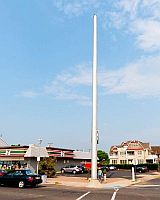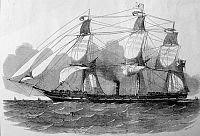 Next to a 7-11 convenience store on 8th Avenue, about a half block from the beach, in the New Jersey shore community of Belmar, there is a tall sewer standpipe, a vertical vent designed to carry the noxious smells from the local sewers. What is unusual about the sewer vent is that there is a small historical plaque at its base. (Or at least, there was a historical marker. Belmar was hit hard by Superstorm Sandy last year, so I don’t know the status of the plaque.)
Next to a 7-11 convenience store on 8th Avenue, about a half block from the beach, in the New Jersey shore community of Belmar, there is a tall sewer standpipe, a vertical vent designed to carry the noxious smells from the local sewers. What is unusual about the sewer vent is that there is a small historical plaque at its base. (Or at least, there was a historical marker. Belmar was hit hard by Superstorm Sandy last year, so I don’t know the status of the plaque.)
The historical marker has nothing to do with Belmar’s sewer system. The “pipe” is, in fact, the foremast of the sailing ship Malta, which sank just offshore on November 24, 1885. The wreck of the Malta is still visible from the beach.
The sailing ship Malta began its life in 1851, as Queen of the South, a three masted iron hulled auxiliary steamer with four boilers and two inclined 2 cylinder engines developing 800 horsepower driving a single screw. She had a speed of 9 knots and had accommodations for 130 passengers.
 She was built for the General Screw Steam Shipping Company by C. J. Mare & Co. of Blackwall and initially traded in their Calcutta run. In 1857 the ship was sold to European & American Steam Shipping Co. and 1859 renamed. In 1860, she was sold again to the East India and London Steam Shipping Company, and reverted to her original name. After several more owners, she had her machinery removed in 1871 and was converted to a full sailing ship. Renamed Malta, she sailed for fourteen years until wrecking on the shores of Belmar, New Jersey.
She was built for the General Screw Steam Shipping Company by C. J. Mare & Co. of Blackwall and initially traded in their Calcutta run. In 1857 the ship was sold to European & American Steam Shipping Co. and 1859 renamed. In 1860, she was sold again to the East India and London Steam Shipping Company, and reverted to her original name. After several more owners, she had her machinery removed in 1871 and was converted to a full sailing ship. Renamed Malta, she sailed for fourteen years until wrecking on the shores of Belmar, New Jersey.
The Malta Shipwreck – “The Malta was en-route from Antwerp to New York with thousands of empty petroleum barrels. At 3:30 AM November 24, 1855, the Malta ran aground during a fierce northeast gale. Within minutes of running aground the surfmen from the nearby Lifesaving Station came to the rescue and attempted to shoot a rescue line across the bow of the stricken vessel. On the third try, the crew aboard the Malta caught the line and secured it twenty feet up the foremast. Lifesavers used a breeches buoy to rescue 23 of the 24 crew. One sailor apparently delirious with fear attempted to swim to shore rather than waiting for his turn on the breeches buoy. His body was found six miles away the next day.”
In addition to providing the securing point for the life-saving line, the foremast lives on as functioning sever vent. An odd sort of immortality, perhaps, but still better than the scrap yard. Thanks to Walter Stevens for passing along the story.

The Malta’s Signage Survived Superstorm Sandy!